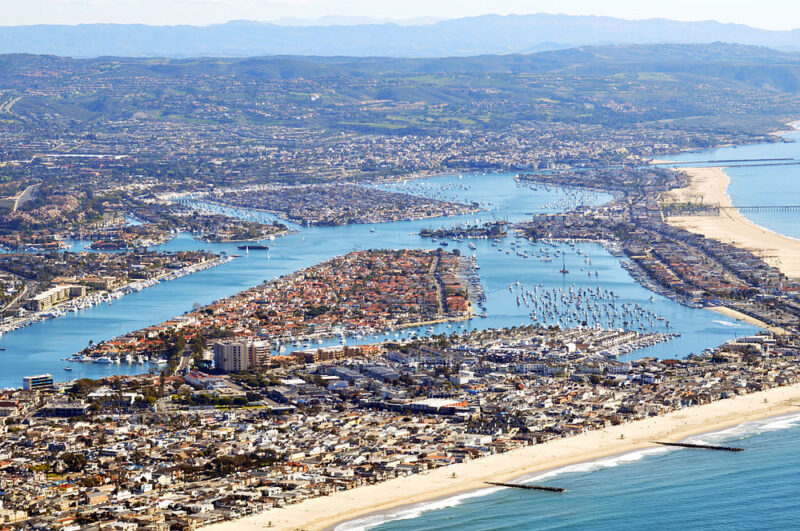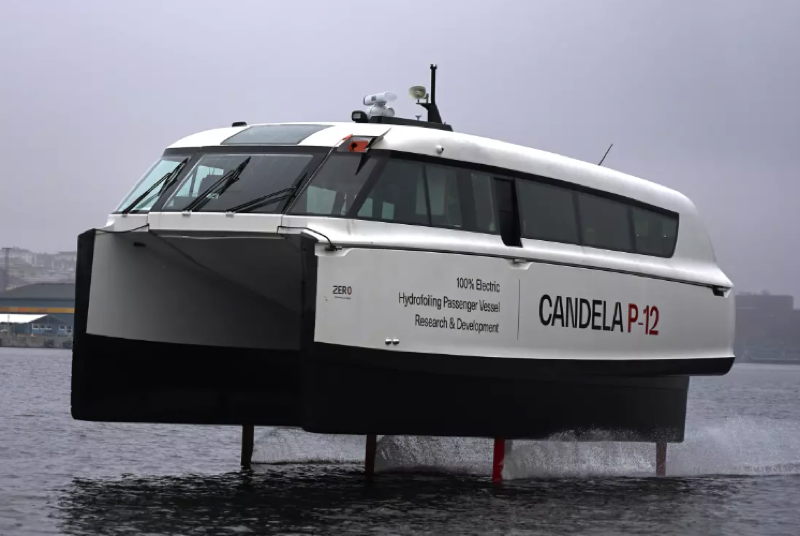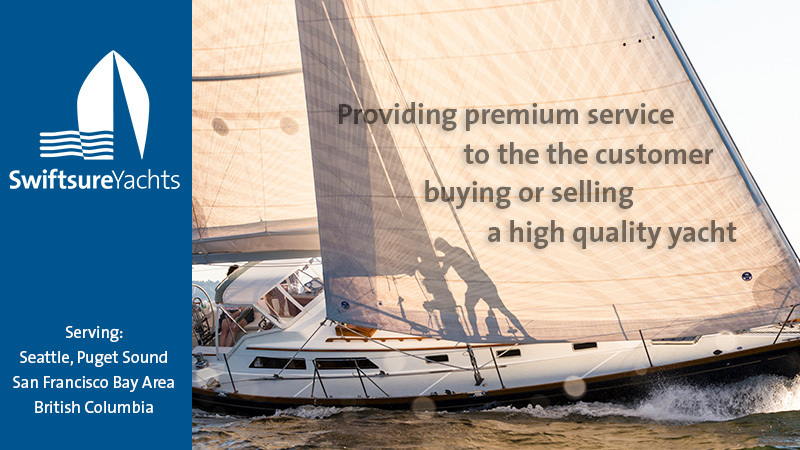
Newport Beach Proposes Increasing Mooring Rent by 300%
Newport Beach’s Harbor Commission has proposed raising rents on public moorings by as much as 300%, stoking outrage among the liveaboard community. There have been allegations of conflicts of interest between the city and the consultant who appraised the anchorages, there are threats of a lawsuit if mooring-rent hikes go through, and there are echoes of headlines about other long-delayed, sudden and extreme fee hikes affecting working-class boaters.
In April, the Newport Beach Harbor Commission voted unanimously to recommend a 300% increase in rents for public moorings to the City Council for Newport’s more than 1,200 onshore and offshore anchorages. (Commissioners said that mooring rates have seen only one “adjustment” — presumably an increase — over the past 20 years.) “Commissioners propose an increase in monthly rents to $7.71 per linear foot for the city’s 478 onshore moorings, up from the current rate of $1.67 per linear foot,” the Los Angeles Times reported. “The monthly rent for the city’s 731 offshore moorings would be raised to a range of $7.77 to $17.78 per linear foot, depending on the mooring length, up from the current rental fee of $3.35 per linear foot.”

In 2023, the Newport Beach Harbor Commission hired Netzer and Associates, a real estate consultant, to appraise the value of moorings in the harbor, according to Samantha McDonald, who wrote Latitude in late May. “The company recommended the city increase the tax rate of the moorings by 800% (yes, you read that correctly, 800%). The Harbor Commission staff agreed that the rate should be increased, but slightly less than the appraisal,” Samantha said. (Samantha and her partner are liveaboards on a CF 37 racer/cruiser; they’ve owned a mooring in Newport Beach for three years.)
Revenue from Newport Beach’s mooring rentals goes into the city’s tidelands fund, which finances the harbor department, maintenance/enhancement of the tidelands, environmental protection and public access/recreation. A harbor commissioner said there’s a $4.6 million deficit in the tidelands fund for the 2023 fiscal year.
At an April meeting of the Harbor Commission, public commenters said there was a potential conflict of interest between Netzer and Associates, “because Netzer is involved with the Newport Aquatics Center — but the city has denied such a conflict,” the L.A. Times reported. Chris Benzen, who lives on a mooring and created the website Stewards of the Harbor (SOTH), which details the current mooring dispute, said that “multiple Harbor Commissioners have dock permits within 500-1000 feet of a mooring field.”
McDonald wrote: “Many members of the Newport Beach mooring community, including myself, see the actions of the Harbor Commission as unjust and corrupt.”
The question of appraisal and value keeps surfacing in Newport Beach, such as the discrepancy between mooring rents and dock rents. “On average dock permit holders pay $12 to $30 per month, while the average mooring (40 feet) pays $133.60 per month,” Benson wrote on the SOTH website, adding, “A dock permit is a superior form of boat storage. [But] the dock permit occupies the same tidelands.”
The Times said that other speakers at the April Harbor Commission meeting pointed out the “apples and oranges” comparison used by the consultant/appraiser, “which referenced public moorings in other cities like San Diego, Monterey, Morro Bay and Santa Barbara, which offer services that Newport Beach moorings do not. Newport Harbor users have access to public facilities but do not have private utilities included with the moorings.”

“Maybe one day I’ll have a dock with a nice boat on it and not have to pay certain amounts, but at this time and at this rate, I will eventually be forced out of it, and you’ll force a lot of us out of [the harbor],” Jake Pollgreen said at the April Harbor Commission meeting, as quoted by the Times.
Benson was quoted by the Times as saying, “‘We’ll issue a legal letter, then if they approve [the rent increases], file for injunctive relief and let the courts decide on these perceived conflicts of interest. It’s unfortunate that we have to sue our city.”
Good Jibes #145: A $2 Sailboat, a Slip, and Squalls (Latitude 38 Verbatim)
This week’s host, Ryan Foland, reads three articles from the June issue of Latitude 38 sailing magazine. Hear “$2 Catamaran, Priceless Adventure” by John Arndt, “Falling In, and Saving Myself” by Apryl Hunt, and “Tire Bouchon, Pt. II — Berkeley to France” by Heather Breaux.

This episode covers everything from boat projects to close calls. Here’s a small sample of what you will hear:
- Where can you find cheap boats?
- How do you knock out a boat project as a team?
- What caused Apryl Hunt’s close call?
- How did she get back to safety?
- What are the ABC Islands?
- Where can you catch the Gulf Stream?
- What’s special about Horta Harbor?
- Where is Brittany, France?
Follow along and read the articles at https://www.latitude38.com/issues/june-2024/#54, https://www.latitude38.com/issues/june-2024/#46, and https://www.latitude38.com/issues/june-2024/#60.
Sign up to get notified when we share a new episode of Good Jibes!
Quality Yachts With Premium Service From Swiftsure Yachts
Swiftsure Yachts offers exceptional service, quality brokerage boats and new yachts for world cruising. Visit our website swiftsureyachts.com.
Electric Boating and Foiling Are Greening Our Blue Planet
Sailing has always been considered one of the greenest forms of transportation on this blue planet. At a recent Wednesday Yachting Luncheon at the St. Francis Yacht Club, we learned more from West Coast pioneers in the electrification of boating that is giving more elements of the boating world the opportunity to go green. We heard from a panel consisting of Sam Seder, operations manager at Navier in Alameda; Veronica Cargay, project manager at Candela in Sausalito/Sweden, and Mike Gunning, sales manager at Electric Yacht in Dana Point.

Foiling took off after the 2013 America’s Cup on San Francisco Bay and has subsequently lifted many sectors of the sailing market, from foiling kiteboards, wingers and Moths to the current America’s Cup and now electric foiling powerboats being developed by Navier in Alameda and Candela in Sweden, the latter with its US base in Sausalito. Additionally, Electric Yacht has been a pioneer in electric auxiliary motors for sailboats. It was founded by Scott McMillan in 2008, with Mike joining in 2010. It was a slow start but saw adoption increase more quickly in 2017 in what Scott called “the Tesla effect” as people became more comfortable with the concept. Given the number of Teslas and now electric auxiliaries in the Bay Area, that comfort has been growing rapidly.
It’s not surprising to see this kind of development in California, where Tesla took the lead in the mass production of electric cars, and we live just miles from one of the world’s first large-scale wind farms, built in the early ’80s at Altamont Pass (at one time, the largest wind farm in the world). Driving through Altamont Pass you see a larger version of the wind generators that are on the stern of many cruising boats, though they’re much smaller than the large-scale wind turbines cranking out clean power today.

California is also where the mass production of small electric yachts was introduced by Duffy Boats in Southern California in 1968. However, Mike Gunning pointed out that the first boat powered by electricity was in 1839 in St. Petersburg, Russia, and from the 1880s to the 1920s electric launches were very popular in much of the developed world. Electric Yacht has now installed over 1200 electric auxiliaries on boats across the US, with plenty of them in the Bay Area where plentiful wind power allows most sailors to sail with minimal need for an auxiliary.

Now Candela and Navier have both developed quiet green foiling boats for recreational and commercial use. The large, heavy and often-empty diesel ferries crossing the Bay are seen as an opportunity for replacement by fast, efficient electric ferries that will take fewer passengers but have shorter transit times, a far smaller carbon footprint, and more flexible docking destinations due to size.

For sailors who appreciate the quiet that comes with sailing, the electric auxiliary has become a trusted friend. According to Mike Gunning, there are about 88,000 sailboats in the US with aging fossil-fueled auxiliary engines. He estimates the cost of an electric propulsion system is about 70% of the cost of a diesel repower; modern electric systems can cost-effectively extend the useful life of many of these older boats while lowering the maintenance and operating costs. Mike acknowledged that, depending on how you use your boat, the electric auxiliary may not be the way to go, but for many looking at a repower it’s an option worth considering. Lin and Larry Pardey cruised the world without any engine at all, and there are now cruisers rounding the world with electric auxiliary only. The Spaniers’ Antrim-designed, Berkeley Marine Center-built scow-bowed, junk-rigged catboat, Rosie G has now cruised from Berkeley to the South Pacific with an electric and solar setup.

All the speakers spoke of the ongoing development of all these technologies. The growing volume of EVs on the road and batteries for homes and boats is increasing production of batteries, which is driving costs down. People have many concerns around electric boats, including “range anxiety,” though we’re often reminded that when Henry Ford first started building cars there were essentially no gas stations, and when most of us bought our first cell phones there were very few cell towers. Some people initially opted to stick with a horse, and later a landline, but the world moved forward.
Sailors have always appreciated the clean, quiet and green aspects of wind power. The electric auxiliary is seeing increasing acceptance, and the type of horizontal wing technology on Daniela Moroz’s fast, foiling kiteboards is now helping lift Candela and Navier into the clean, green world of electric foiling powerboats. All three companies continue the pioneering tradition of the California working waterfront. It will be interesting to follow the evolution of wings, foils and the green world of sailing on our blue planet.
Did you know? Latitude 38’s classifieds offer FREE online ads with photos for boats and gear priced under $1,000. Clean out the dock box or garage by posting them here. And someone just posted a nice-looking Olson 25 for $12,900.
- Events
- Youth Sailing
- West Coast Sailing
- Northern California Racing
- Racing
- International Racing
- Current News
All the News That Didn’t Fit (in Racing Sheet)
With late-spring racing in full-on jammin’ mode, we ran out of space for Race Notes in June’s Racing Sheet. So we promised to run them here. We’ve added a couple of notes from more recent events as well.
Match Racing Update
A whole slew of match-racing activities characterized the spring sailing season. We’ll dive in with California Dreamin’. The series made four stops this year, at San Diego, Balboa, St. Francis and Long Beach Yacht Clubs. Shawn Bennett, Shannon O’Gallagher and Ryan Seago each won stops. Seago, of Detroit, MI, and sailing for Bayview YC, topped the series.
Long Beach YC hosted the Ficker Cup on April 19-21. Kiwi-American Scotty Dickson, sailing for LBYC with crew Erik Berzins, Garrett Brown, Steve Flam, Zachary Hanna and Shane Young, topped the eight-team field from six countries. The top three ranking Ficker Cup skippers (Scotty Dickson, Megan Thomson and Cole Tapper) qualified for the Congressional Cup.

LBYC then hosted the 59th Congressional Cup on April 24-28. Chris Poole repeated as champion. He sails for Seawanhaka Corinthian Yacht Club and hails from Westport, CT. See our report in April 29’s ‘Lectronic Latitude here. Learn more about the World Match Racing Tour at https://wmrt.com.
And Then There’s Team Racing …
Newport Harbor YC hosted the Baldwin Cup on April 18-20. In a 2v2 format in a stadium setting, 20 teams competed for top honors in Harbor 20s. In the final round, NHYC Thunder vanquished St. Francis YC Blue. Find the nitty-gritty at https://www.nhyc.org/baldwincup.

On April 28-29, Stanford won the 2024 College Sailing Women’s Team Race National Championship. MIT and Harvard hosted the regatta on April 28-29 in Boston, using FJs and 420s. Michelle Lahrkamp/Ellie Harned, Vanessa Lahrkamp/Gwendolyn Donahue, and Hannah Freeman/Alice Schmid secured the victory for the Cardinal.
How about a FREE hat with a gift subscription and t-shirt for Father’s Day.? Order a subscription and shirt for dad from our store and we’ll also send him a FREE Latitude 38 hat!
The Point Loma Pointers (of San Diego) won the 2024 High School Team Racing Championship on May 17-19 in Oak Harbor, WA. Twelve teams competed in CFJs. The winning team members were Anton Schmid, Wyatt Kelly, Harrison Strom, Sabrina Anderson, Skye Terrell, Preston Miller and Jonah Wozniak.
Courtesy of an unblemished 9-0 performance on June 1, the St. Francis YC team went into the second and final day of New York YC’s Women’s 2v2 Team Race with a two-point cushion over second place. But then NYYC won twice and Newport Harbor YC won once. But StFYC won their next two races to guarantee the title with one race still remaining. Congratulations to Molly Carapiet (skipper/team captain), Rosalind Meade, Samantha Steele, McKenzie Wilson, Lindsey Baab (skipper), Helen Lord, Kate Shiber and Elena VandenBerg. The two-day regatta took place at NYYC’s Harbour Court in Newport, RI, using Sonars.
Kudos to Some More Sailors
We reported on the Bullship Race for 8-ft El Toros in May’s Racing Sheet, but the May issue of Lake Merritt Sailing Club’s Telltale newsletter added some important details. Special awards went to:
- First boat to finish, Lino Pera El Matador Perpetual BS Race Trophy: Chris Sullivan
- First woman to finish, Monterey Herald Perpetual Sirena Award: Rowena Carlson
- Second boat to finish, Joaquin Koepler Memorial Perpetual: Vaughn Seifers
- First maiden voyager to finish, Jorge Gutekunst’s Ondine Perpetual: Rowena Carlson
- First heavyweight to finish, Clydesdale: Chris Nash
- First elder to finish, El Viejo: Vaughn Seifers
- First wooden boat to finish, Woody: Tom Tillotson
- First LMSC skipper to finish, Robinson Perpetual: Vickie Gilmour
- Last boat to finish, Tailender: Sam Normington

Jack Kisling of Capitola won the All-PCCSC Sportsmanship Award for the 2023-2024 school year. Jack attends Cal Poly in San Luis Obispo. The PCCSC (Pacific Coast Collegiate Sailing Conference) has more than 500 sailors in 18 universities in the Pacific Coast region. Jack skippers Cal Poly’s offshore sailing team.
Stanford junior Vanessa Lahrkamp won 2024 Quantum Women’s College Sailor of the Year, as well as PCCSC Open and Women’s Skipper of the Year. For more PCCSC news, see https://pccsc.collegesailing.org.
Westwind Yacht Management — Washing, Waxing and Varnishing
Westwind Yacht Management: Premiere Yacht & Fleet services for the San Francisco Bay Area.


